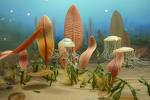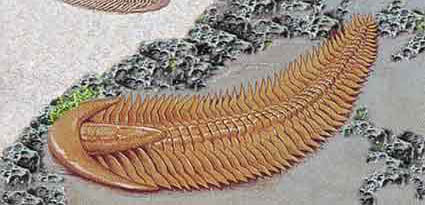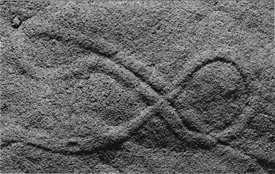 |
 |
 |
 |
 |
Produced
by the Population Genetics and Evolution class, Furman University |
||||
 |
 |
 |
 |
 |
Produced
by the Population Genetics and Evolution class, Furman University |
||||
 |
The
Ediacaran |
 |
||
 |
The Ediacaran Period (635-540 mya) was first named by Sokolov in 1952, to distinguish a period of evolutionary radiation among soft-bodied forms found in the Ediacara Hills of South Australia. There has been considerable confusion over the usage of 'Ediacaran' and 'Vendian', and their respective time periods; however, the Ediacaran is now recognized as the appropriate term for this period. Although this period is much less well-known than the Cambrian that follows, it harbored a radiation of life forms that was nearly as impressive. The ecologically diverse assemblages were dominated by filter-feeding animals, but the first predators also appear--perhaps selecting for the evolution of animals with hard shells or exoskeletons that radiate in the Cambrian. Some Ediacaran fossils are placed into existing phyla; Kimberella is classified as an early, soft-bodied mollusc, Arkarua may be the earliest echinoderm, and Eoporpita, may be a cnidarian. The affinities of other species like Spriggina, Tribrachidium, Charnia, Dickinsonia, and Pteridinium are still debated; they may belong to an existing phylum or they may belong to an extinct 'stem' phylum that flourished during this period of early animal radiations. Indeed, some of the discoid fossils like Ediacaria and Cyclomedusa may not be animals at all; they may be microbial mats. The Ediacaran was a very important period for animal evolution. Newer fossils from the Doushantuo Formation in China, like Vernanimalcula (the oldest bilaterally-symmetrical animal) and fossilized embryos, are contributing to our knowledge of how, when, and why different animal body plans evolved. |  |
||
| Above: Charniodiscus fossil; Below, Spriggia painting. Images from: Edward T. Babinski | Above: Ediacaran scene; from: BioBookPaleo2 Below: Gordia fossil burrow; Images from: Answers.com |
|||
 |
 |
|||